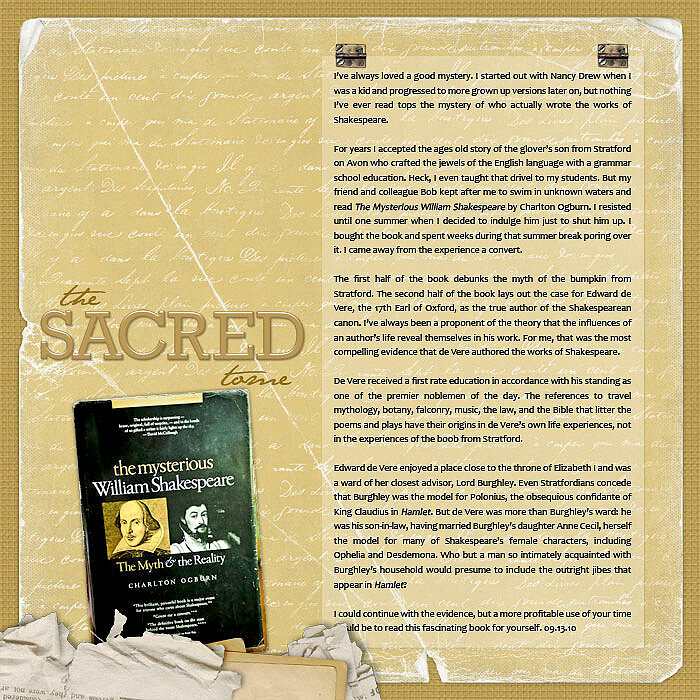

 Give a Cheer
Give a Cheer
Designer Digitals Products: Lynn Grieveson: Worn Page Edges No. 03, Worn Photo Edges No. 04; Katie Pertiet: Classic Embossed Grids No. 03 Paper Pack, Collection Manuscrite Paper Pack, Stuffed Edge Documents No. 01 (partially recolored), Hinge Pack; Michelle Martin: Stina Kit (alpha); Cassie Jones: How'd They Do That? No. 19 Recoloring Essentials; Fonts: Jane Austen, Candara
Journaling: I’ve always loved a good mystery. I started out with Nancy Drew when I was a kid and progressed to more grown up versions later on, but nothing I’ve ever read tops the mystery of who actually wrote the works of Shakespeare.
For years I accepted the ages old story of the glover’s son from Stratford on Avon who crafted the jewels of the English language with a grammar school education. Heck, I even taught that drivel to my students. But my friend and colleague Bob kept after me to swim in unknown waters and read The Mysterious William Shakespeare by Charlton Ogburn. I resisted until one summer when I decided to indulge him just to shut him up. I bought the book and spent weeks during that summer break poring over it. I came away from the experience a convert.
The first half of the book debunks the myth of the bumpkin from Stratford. The second half of the book lays out the case for Edward de Vere, the 17th Earl of Oxford, as the true author of the Shakespearean canon. I’ve always been a proponent of the theory that the influences of an author’s life reveal themselves in his work. For me, that was the most compelling evidence that de Vere authored the works of Shakespeare.
De Vere received a first rate education in accordance with his standing as one of the premier noblemen of the day. The references to travel mythology, botany, falconry, music, the law, and the Bible that litter the poems and plays have their origins in de Vere’s own life experiences, not in the experiences of the boob from Stratford.
Edward de Vere enjoyed a place close to the throne of Elizabeth I and was a ward of her closest advisor, Lord Burghley. Even Stratfordians concede that Burghley was the model for Polonius, the obsequious confidante of King Claudius in Hamlet. But de Vere was more than Burghley’s ward: he was his son-in-law, having married Burghley’s daughter Anne Cecil, herself the model for many of Shakespeare’s female characters, including Ophelia and Desdemona. Who but a man so intimately acquainted with Burghley’s household would presume to include the outright jibes that appear in Hamlet?
I could continue with the evidence, but a more profitable use of your time would be to read this fascinating book for yourself. 09.13.10
No products have been added to this project.
Thanks for spreading positivity!
September 18, 2010